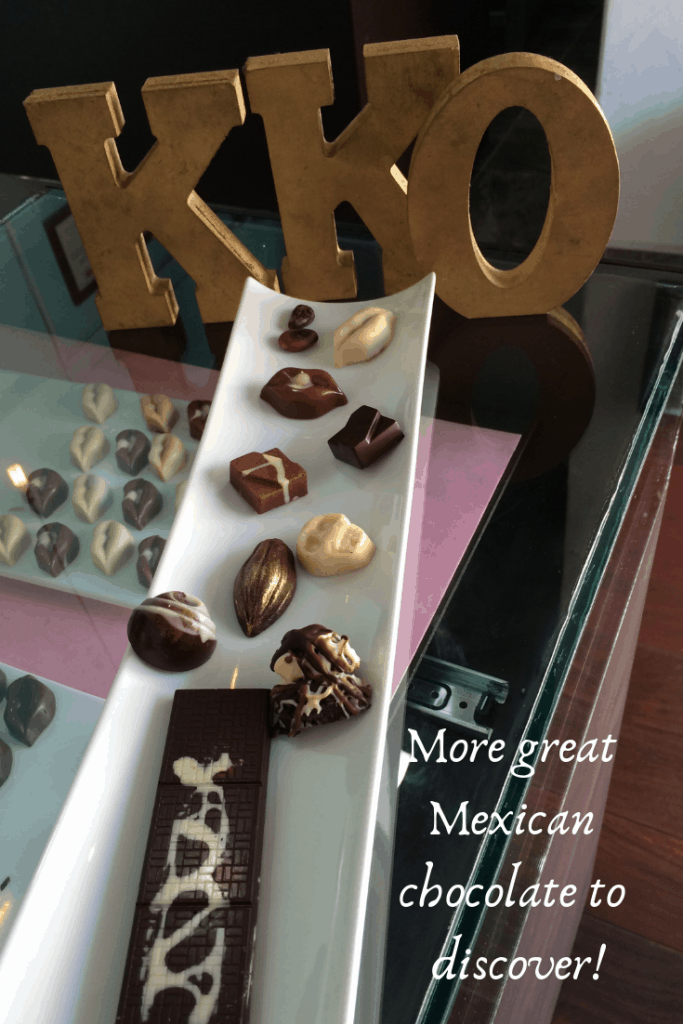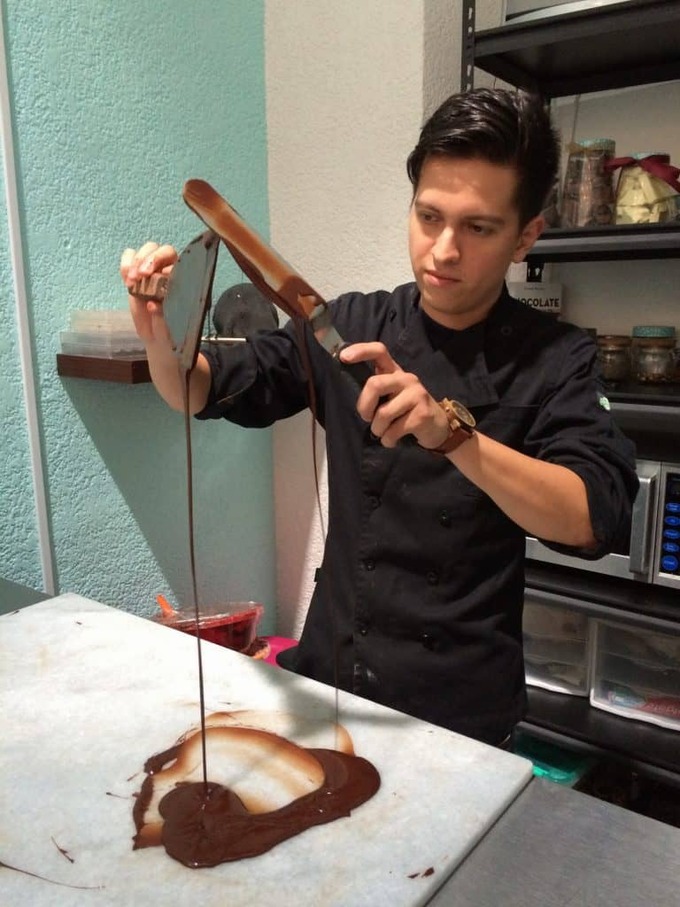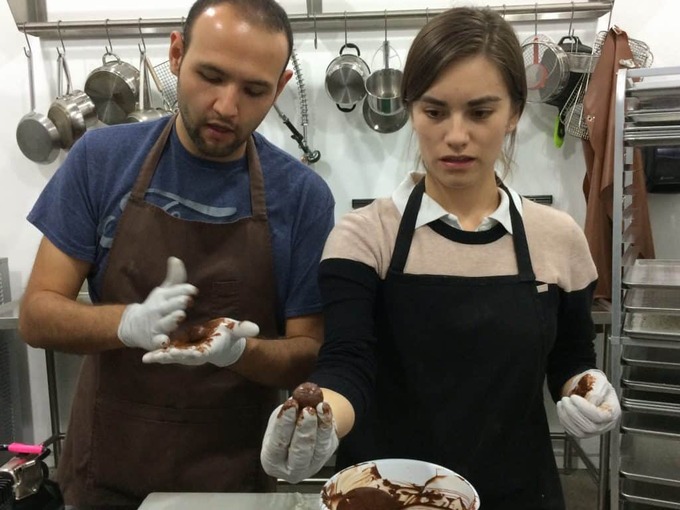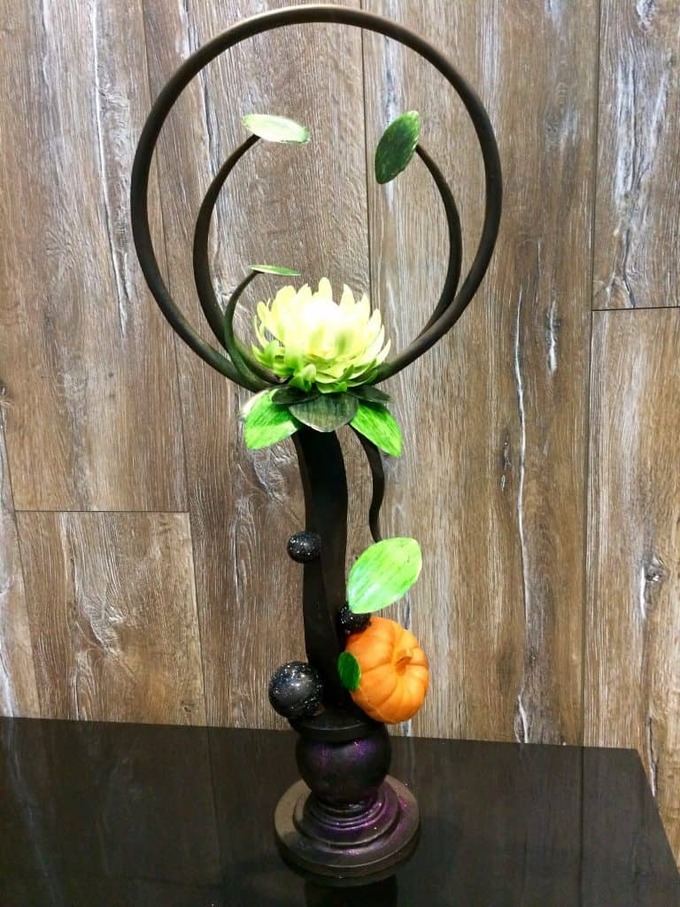Traditional chocolate in Mexico has always been coarse and less sweet than chocolate from other parts of the world. But that is changing. As I explained in this post featuring Que Bo! Chocolate from Mexico City, Mexican chocolate has gone through an evolutionary process in which a new level of sophistication has emerged. That is certainly true of the two companies I profile in today’s post.

KKO Chocolateria is a fine example of contemporary mexican chocolate
KKO Chocolateria is situated in the heart of Tlaquepaque, an artisan village located just minutes from Guadalajara–Mexico’s second largest city. KKO is a cute little chocolate boutique run by Angelica Aguayo and her nephew Mauricio Varela, who is now the chief chocolatier. Both Angelica and Mauricio are graduates of the Que Bo! Chocolateria Mexicana Evolutiva school of chocolate and they use Que Bo! couverture to make their scrumptious chocolates.

I had the pleasure of meeting Angelica, Mauricio, and Angelica’s charming husband Alejandro Aviles in KKO’s new shop at #12 Matamoros in the heart of Tlaquepaque (their new location as of September, 2015.) The space is small, but the creativity is endless. What impressed me most about KKO is their philosophy of combining tradition with the evolution of chocolate. “We’ve tried to rescue some of the old traditions to do with our Mexican roots by serving traditional Mexican cacao-based drinks hot, cold, or frappéd,” says Mauricio. “They’re really good for the blood and your immunity system. “
“You eat chocolate with your senses,” says Angelica of KKO, who says it’s no surprise that the same chocolate can taste different to us on different days depending on the other variables happening at that moment. My favourite chocolate at KKO was the “Cluster” (shown to the top right of the bar in the photo above) which contains contains white chocolate, 45% milk chocolate, 95% dark chocolate, black fig jelly, and nuts.
Like Fernel of AMO Cacao, Mauricio stresses the health benefits of cacao and that they are attempting to change the way Mexicans think about chocolate. “We explain to people that we don’t sell chocolate candy. We sell pure cacao products that are actually good for them. Cacao is good for the mind, soul, and the heart.”

Another important thing that I learned from Mauricio is that as with writing or any other creative process, chocolatiers can’t force the creative juices to flow. “You have to be happy when you’re making chocolate,” says Mauricio. “The chocolate will pick up on your negative feelings and the batch will fail.”
I really enjoyed my visit at KKO. But while in the area of Guadalajara, I also had to get over and visit Manuel Flores at Caramell Boutique located in the Americana neighbourhood of Guadalajara. Manuel is a partner with world-renown Chef David Bonet in this very high-tech chocolate shop. I watched Manuel and his assistant create exquisite cognac chocolate truffles and was surprised at the tools that were used in his chocolate kitchen. In the same city, but an absolute world away from the primitive hands-on cacao kitchen of AMO Cacao. Both are great Mexican chocolate in their own unique way.

However, with respect to exclusively being Mexican, I must tell you that Caramell Boutique uses Valrhona couverture from France and Cacao Barry couverture (based in Belgium) in some of their creations, and a limited amount of locally sourced Mexican cacao beans as well. So you may not be precisely sure as to the exact origin of the chocolate you are eating at Caramell, though there is no doubt you will enjoy the sophisticated flavour and silky texture, as well as the artistry of their creations.

The team at Caramell Boutique makes uber creative chocolate sculptures and has won numerous awards.
I hope you’ve enjoyed this post about these talented chocolatiers of Tlaquepaque and Guadalajara. Chocolate in Mexico has indeed evolved onto the world stage. Stay tuned for more when we visit the Merida area of Mexico.

Another great post. I love chocolates. I want these mexican chocolates. I can still remember the taste though in my memory. Thanks for sharing this with us.
Wow, these pieces look simply divine. Mexico has such awesome treats. Thank you for sharing this journey of yours.
Hi Doreen,
I love their philosophy about cacao based chocolate and treats instead of candies. Apart from that, I love the chocolate art. Thank you for this post, there were so many facts I didn’t know about Mexican chocolate. Now I have more reasons to love it!
Zaria
Thanks for you comment, Zaria.
I think that’s one of the special things about Mexican chocolate. There is a strong mystical connection that connects back to the Mayans’ belief that cacao was the food of the gods.
These posts make me more and more aware what an art form chocolate making really is. There’s always something almost indescribable to admire about taking a great thing and making it into a form of art.
So true, Jeri. I, too, have been amazed at the artistry certain chocolate artisans can achieve in their creations. I had no idea when I started out in my chocolate research back in 2009 how endless the possibilities are!
Until your posts on chocolate, I’d never have thought of chocolate making as a fine art, but it sure can be! Your pictures are proof of that. I think I’d have troubles devouring something that looks so beautiful.
Thx for your comment, Ramona. Then I am achieving my goal, as it is indeed to get people to start thinking about chocolate as more than candy. It is a power food, and it is a source of creativity and inspiration.
I would have never guessed that Mexico has good chocolate. I always considered the Europeans the leaders in chocolate quality. I still need to taste the Mexican chocolate to be absolutely convinced it can compete with the Belgian one, for instance.
Anda, I assure you that you will be blown away by the flavour of the artisan chocolate you can experience in Mexico. I began my chocolate research in 2009 in Belgium, as like you, I thought that was THE place for the best chocolate. The Belgians certainly do make some great chocolate. But keep in mind that no cocoa grows in Belgium. So the beans must be processed and make the long boat ride from the growing regions to the port of Amsterdam, and then be sent by rail (or via some other form of transportation) to the European countries like Holland, Switzerland, and Belgium to be made into the processed chocolate we grew up on. Which do you think would taste fresher?
I love the chocolate in the first picture that is shaped like lips! Fun, fun, fun!
What a treat to get to visit with people creating art from cacao.
Rose, I must tell you. I rarely am disappointed in the creativity I see in artisanal chocolate shops! Creativity and chocolate seem to go hand in hand. 🙂
I love that they are serving traditional Mexican cacao-based drinks. Those would be interesting to sample. I also like the comment that the chocolate can pick up on negative feelings. Everything turns out better when you’re happy making it!
So true, Donna. I find that everything I make tastes better when I am in a good mood. Maybe that’s why I like to have a glass of wine why I’m making dinner! 🙂
Another great post. I get so jealous because I used to love chocolate. Now that I am pre-diabetic I stay away from all sweets. I can still remember the taste though in my memory.
Thanks for sharing this with us.
William, if you eat pure dark chocolate or cocoa nibs, it’s actually GOOD for people with diabetes. According to medical studies, having one square of 70% cocoa or higher chocolate represents only a single serving of carbohydrates and is manageable for most diabetics. Check with your doctor!
Love the photos of chocolate in action!
Doreen,
Nice post. I could not expect that in Mexico there is so much chocolate
I love chocolate and everything that is connected with them.
Actually, I live in Belgium and here chocolate is everywhere. Not far from my place there is even a chocolate museum that makes similar chocolate sculptures and you can observe the process. Pass by if you are here 🙂
Hello Kristina. Are you in Brussels? I was in the chocolate museum in Brussels and enjoyed it.
Yes, indeed Brussels and Belgium in general really does have chocolate join every corner. We certainly saw that in the places we visited. It’s definitely not like that in Mexico! the chocolate shops are few and far between. But they are certainly worth searching out as I have done.
Hi Doreen, I just love their line of thinking that great chocolate comes from happy chocolate makers. I always knew chocolate had happiness corporared right inside 🙂 and their sculptures are beautiful!
Hi Susan. Yes, that’s the really great thing about people involved in the world of chocolate. Most of them are really passionate people. Most of those emit a super-positive energy. There are a few whose passion is somewhat ego-centric. But for the most part, chocolate people are exuberant happy people. 🙂
Wow, Doreen, you saved the best for last. That chocolate sculpture is unbelievable. Can you imagine how that would improve the organizational rubber chicken dinners? Since you have started sharing your chocolate explorations with us, I must agree with Mauricio – Cacao is good for the mind, soul, and the heart.” You are certainly teaching us that.
Hi Lenie: I’m assuming you mean the ‘best (pic) for last? I’ve got more Mexican chocolate to tell you about, and next month … it will be Grenada, as I’m off to the Chocolate Festival there. Can’t wait!
They both sound delicious Doreen. Nice inside look at the making of these chocolates.
Thanks, Ken. I really am trying to give folks different views of the world of chocolate so that they can develop a greater understanding and appreciation for chocolate and cacao.
Just beautiful Doreen. I never would have connected Mexico and fine chocolates but you have really opened my eyes!
Thanks, Marty. That means I’m doing my job effectively!
Doreen — always fun to visit these chocolate shops vicariously. I didn’t know about Mexico’s chocolate known for being coarse and less sweet. Is the entire sculpture made of chocolate or just the flowers? Amazing.
Hi Jeannette and thanks for your comment. The sculptures made at Caramelle are a blend of chocolate and a special sugar that is blended specifically to craft sculptures.
I’ve enjoyed reading your updates on your travels in MX! I just moved here myself and am creating a bucket list of sites to visit this year–Tlaquepaque is on my radar for May as it’s near me and I’m in need of a good chocolate fix!
Right on, Kate! I’m very sure you will enjoy Tlaquepaque. Let me know how your trip goes, and say Hi to Angelica and Mauricio at KKO if you make it there for a tasting of their delicious chocolate offerings.
These chocolatiers truly love their work. The photos are beautiful and yummy too.
Hi Sabrina and thx for your comment. Yes, the chocolatiers that truly enjoy their work are the ones who are best at it. Passion is the key to brilliance!
How fascinating. I had no idea chocolatiers created sculptures from chocolate that would make any hostess proud to have sitting on her dining room table.
Hi Bev and thanks for your comment. Yes, you can get beautiful chocolate turkeys at Constance Popp Chocolatier during the Thanksgiving and Christmas season (by special order.) And if you happen to be travelling abroad, you can be blown away by the chocolate sculptures and chocolate fashion show at the Salon du Chocolat chocolate shows held in different cities around the world. Here’s my post on the salon du chocolat in Paris: https://chocolatour.net/salon-du-chocolat-in-paris/. Check it out!